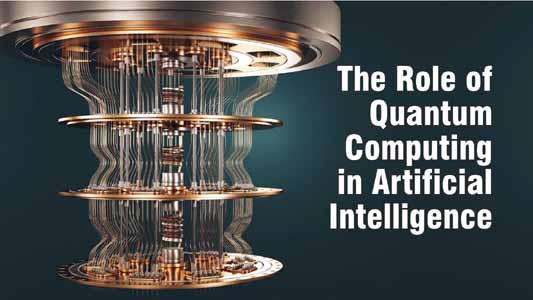Abstract
Artificial Intelligence (AI) and Quantum Computing (QC) represent two of the most transformative domains in contemporary science and technology. While AI excels in pattern recognition, decision-making, and learning from data, quantum computing promises exponential computational advantages by leveraging quantum mechanical phenomena. As classical computing approaches its physical and practical limits, integrating quantum computing into AI systems offers a new paradigm for solving problems previously deemed intractable. This article explores the theoretical foundations, current applications, key challenges, and future possibilities of combining quantum computing with artificial intelligence.
Introduction
The last two decades have witnessed a technological surge powered by AI advancements, particularly in machine learning, deep learning, and natural language processing. Simultaneously, quantum computing has progressed from theoretical constructs to experimental hardware demonstrating quantum advantage for specific tasks.
Quantum computers leverage superposition, entanglement, and quantum interference to perform computations in fundamentally different ways from classical computers. The potential synergy between AI and QC, often referred to as Quantum AI (QAI), has generated immense research interest. At the core of this synergy is the possibility of using quantum hardware to accelerate AI algorithms, improve data representation, and explore new AI paradigms grounded in quantum mechanics.
Background Concepts
1.1 Quantum Computing Fundamentals
Quantum computing is built on the principles of quantum mechanics. Its core components include:
- Qubits: The basic unit of quantum information. Unlike classical bits, qubits can exist in a superposition of states |0⟩|0\rangle|0⟩ and |1⟩|1\rangle|1⟩, represented as |y⟩=a|0⟩+b|1⟩|\psi\rangle = \alpha|0\rangle + \beta|1\rangle|y⟩=a|0⟩+b|1⟩, where a\alphaa and b\betab are complex amplitudes.
- Entanglement: A non-classical correlation between qubits. Entangled qubits cannot be described independently, allowing for faster information propagation and correlation tracking.
- Quantum Gates: Analogous to classical logic gates, these manipulate qubit states. A sequence of quantum gates forms a quantum circuit.
- Measurement: The act of observing a qubit collapses its state to one of the basis states. Measurements are probabilistic and influence computation outcomes.
- Quantum Parallelism: Due to superposition, a quantum computer can process multiple inputs simultaneously, enabling exponential speedup for certain problems.
1.2 Artificial Intelligence Overview
AI encompasses computational techniques that enable machines to perform tasks typically requiring human intelligence, such as:
- Machine Learning (ML): Algorithms that improve performance through experience (data).
- Deep Learning (DL): Neural network architectures with many layers, capable of learning complex representations.
- Reinforcement Learning (RL): An agent learns to make decisions by interacting with an environment and receiving feedback.
- Natural Language Processing (NLP) and Computer Vision (CV): Specialized fields within AI for understanding text and images, respectively.
Synergies between Quantum Computing and AI
Quantum computing can enhance AI in several areas, both in theory and practice. Key intersections include:
2.1 Quantum Speedup for Machine Learning
One of the most anticipated benefits of quantum computing is computational speedup. Some examples include:
- Quantum Linear Algebra: The Harrow-Hassidim-Lloyd (HHL) algorithm allows solving systems of linear equations exponentially faster than classical methods. Since many ML problems reduce to linear algebra (e.g., least-squares regression, PCA), this offers a direct route for quantum acceleration.
- Quantum Support Vector Machines (QSVMs): Quantum kernels can map data into high-dimensional Hilbert spaces more efficiently, potentially improving classification accuracy with fewer resources.
- Quantum Principal Component Analysis (QPCA): Can extract the principal components of a dataset faster under specific conditions, aiding dimensionality reduction and noise filtering in large-scale ML.
2.2 Quantum Data Encoding (Quantum Feature Maps)
In hybrid classical-quantum models, classical data is encoded into quantum states through quantum feature maps. These feature maps transform data into a quantum Hilbert space where patterns might be more separable.
Encoding techniques include:
- Amplitude Encoding: Amplitude encoding is a method of representing classical data within the amplitudes of a quantum state. It’s a crucial technique in quantum machine learning (QML) and other quantum algorithms where classical data needs to be translated into a form that can be processed by quantum computers. Essentially, the information is stored in the “height” or magnitude of the quantum wave function, rather than in the qubit’s state (0 or 1).
- Angle Encoding: Angle encoding is a fundamental technique for representing classical data within the quantum realm, often used in Quantum Machine Learning (QML) and other quantum algorithms. It leverages the quantum properties of qubits, specifically their rotation angles and phases, to encode information from classical datasets into quantum states.
- Qubit Encoding: Qubit encoding refers to the methods used to represent and store information using qubits, the basic units of quantum information. Unlike classical bits, which are either 0 or 1, qubits can exist in a superposition of both states simultaneously, and can also be entangled. This allows for more complex and efficient data storage and processing. Different encoding schemes are used depending on the physical system and the desired properties of the qubit.
Choosing the right encoding is crucial, as it directly affects a quantum model’s performance and trainability.
2.3 Quantum Neural Networks (QNNs)
Quantum Convolutional Neural Networks (QCNNs) are a type of quantum machine learning model that combines the principles of quantum computing with classical convolutional neural networks (CNNs). They aim to leverage quantum mechanics to enhance the performance of CNNs, particularly for tasks like image recognition and other pattern recognition problems.
Here’s a more detailed explanation:
1. Classical CNNs and their Limitations:
- CNNs are powerful deep learning models, especially for image processing, because they can learn hierarchical features from data.
- However, training CNNs can be computationally expensive and memory intensive, especially for large datasets or complex tasks.
- Classical CNNs also face limitations when dealing with data that has inherent quantum properties or when trying to model quantum phenomena.
3. Quantum Neural Networks (QNNs) and their Potential:
- QNNs integrate quantum computing principles into neural network architectures.
- They aim to enhance computational efficiency and potentially achieve quantum advantages for certain machine learning tasks.
- QNNs can leverage quantum phenomena like superposition and entanglement to represent and process data in potentially more efficient ways.
3. QCNNs: Combining CNNs and Quantum Computing:
- QCNNs specifically adapt the CNN architecture to a quantum computing environment.
- They utilize quantum circuits (parameterized quantum circuits or PQCs) as building blocks for convolutional and pooling layers.
- This allows them to potentially perform convolutions and downsampling operations more efficiently than classical CNNs, especially for large datasets or complex patterns.
- QCNNs can be used to solve classification problems in quantum physics and chemistry by mapping classical data to quantum states.
4. Key Concepts in QCNNs:
- Quantum Convolutional Layer: Replaces the classical convolution layer with a quantum circuit that performs feature extraction on quantum states.
- Quantum Pooling Layer: Similar to classical pooling, but implemented with quantum operations to reduce data dimensionality.
- Hybrid Approach: QCNNs often employ a hybrid approach, using classical optimizers to train the parameters of the quantum circuits.
- Data Embedding: Classical data needs to be encoded into quantum states before being processed by the QCNN.
QNNs aim to mimic classical neural networks using quantum circuits. Approaches include:
- Variational Quantum Circuits (VQCs): Parameterized quantum circuits optimized using classical gradient-based methods. These are the building blocks for quantum classifiers and QNNs.
- Quantum Boltzmann Machines (QBMs): A quantum version of probabilistic graphical models like Restricted Boltzmann Machines, used in generative modeling.
- Quantum Convolutional Neural Networks (QCNNs): Designed for quantum data, these can also be applied in supervised learning tasks by mimicking convolutional layers.
3. Key Applications of Quantum AI
3.1 Drug Discovery and Molecular Modeling
AI has already accelerated molecular simulations, but quantum computing can simulate quantum systems natively. Quantum AI can:
- Optimize molecular structures
- Predict protein folding
- Model chemical interactions with higher fidelity
IBM and Google are exploring QAI techniques to simulate molecular systems beyond the reach of classical supercomputers.
3.2 Financial Modeling and Portfolio Optimization
Quantum-enhanced ML can solve high-dimensional optimization problems, such as:
- Risk assessment
- Option pricing
- Portfolio optimization using quantum annealers (e.g., D-Wave)
Quantum reinforcement learning (QRL) offers new strategies for dynamic financial decision-making under uncertainty.
3.3 Natural Language Processing
Quantum language models are an emerging field. Early efforts use QNNs for sentiment analysis, classification, and syntactic parsing. Although NLP with quantum models is still in its infancy, the promise lies in:
- Richer data representations
- Smaller models with high expressivity
- Reduced sample complexity
3.4 Anomaly Detection and Cybersecurity
Quantum AI models have shown potential in detecting anomalies in complex systems, including:
- Intrusion detection in cybersecurity
- Fraud detection in finance
- Predictive maintenance in industrial systems
Quantum-enhanced kernel methods may uncover subtle patterns missed by classical models.
Current Implementations and Tools
Several platforms and tools are driving the development of QAI:
- IBM Qiskit Machine Learning: Offers modules for QSVMs, QNNs, and data encodings.
- PennyLane (Xanadu): A Python library for hybrid quantum-classical ML with automatic differentiation.
- TensorFlow Quantum (TFQ): Integrates quantum circuits with TensorFlow for building hybrid models.
- Amazon Braket and Microsoft Azure Quantum: Provide cloud-based quantum computing services.
Quantum hardware is still in the NISQ (Noisy Intermediate-Scale Quantum) era, limiting the number of qubits and circuit depth. Nevertheless, variational approaches mitigate noise through hybrid algorithms.
5. Challenges in Quantum AI
5.1 Quantum Hardware Limitations
- Noise: Quantum gates are error-prone, leading to decoherence and loss of information.
- Qubit Count: Current devices support tens to hundreds of qubits, limiting problem size.
- Scalability: Implementing large-scale QNNs or training over large datasets is infeasible with current hardware.
5.2 Data Input Bottleneck
Efficiently encoding classical data into quantum systems remains a major bottleneck. The cost of data loading can outweigh any computational benefits unless the dataset is small or structured.
5.3 Algorithm Development
Many quantum ML algorithms are still theoretical or heuristic. There is a lack of:
- Rigorous performance guarantees
- Clear quantum advantage for general-purpose ML
- Understanding of learning capacity and expressiveness of QNNs
5.4 Interpretability
QAI models are harder to interpret than their classical counterparts due to the probabilistic and high-dimensional nature of quantum states.
Future Directions
6.1 Quantum Advantage for AI
As hardware matures, certain ML tasks may show provable quantum advantage, such as:
- Learning from quantum data (quantum chemistry, physics)
- Combinatorial optimization
- Generative modeling with limited samples
6.2 Hybrid Architectures
Near-term success is likely through hybrid quantum-classical systems, where quantum modules perform subroutines (e.g., kernel evaluation, optimization) within a classical AI pipeline.
6.3 Quantum Pretraining and Transfer Learning
Emerging ideas include using quantum models for pretraining representations that are fine-tuned classically, or vice versa.
6.4 Quantum AutoML
Quantum optimization techniques, such as quantum annealing and Grover search, could accelerate AutoML processes like:
- Model architecture search
- Hyperparameter tuning
- Feature selection
6.5 AI-Assisted Quantum Programming
Conversely, AI can assist quantum development through:
- Circuit optimization
- Noise reduction strategies
- Quantum error correction codes
- Adaptive learning algorithms for quantum experiments
Conclusion
Quantum computing holds enormous potential to reshape artificial intelligence, offering computational resources and paradigms that go beyond the capabilities of classical systems. While current limitations prevent full-scale deployment of quantum AI systems, the ongoing development of quantum hardware, algorithms, and hybrid models is rapidly expanding the frontier.
AI problems involving optimization, large-scale linear algebra, and high-dimensional pattern recognition are particularly











